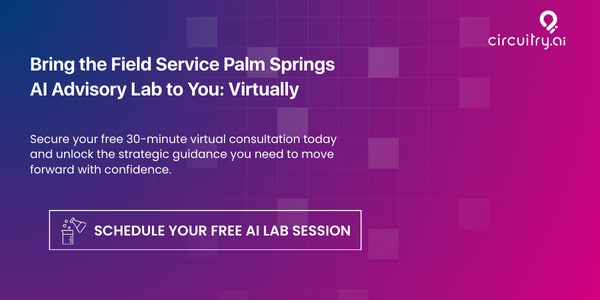This same scenario plays out in service contact centers every day. A customer calls in with an issue: “The excavator shuts down about 10 minutes into use.” The dispatcher logs the complaint, but the notes are brief. There isn’t time to check prior service history or scan for related bulletins. With limited details to work from, it’s treated like a standard ticket, and the dispatcher assigns the nearest available technician, without deeper triage or confirmation on what the job might require.
The technician drives nearly two hours, only to find a common fault: a clogged fuel filter. But the replacement part isn’t on the truck, and the repair can’t be completed on the first visit. A follow-up is scheduled, the SLA is missed, and the customer’s equipment remains out of service longer than it should.
Circuitry.ai’s Service AIdvisor was purpose-built for manufacturers and designed to solve these exact problems, without forcing service teams to overhaul the way they work. Service AIdvisor is a conversational AI-powered advisor trained on your company’s knowledge.
Service AIdvisor delivers:
- Real-time, context‑aware diagnostics
- Guided troubleshooting
- Parts recommendations
Here are three inefficiencies holding field service teams back and how to resolve them.
1. Triage lacks depth and consistency
KPI impacted: Mean Time to Resolution (MTTR)
Triage is one of the most critical stages in the service workflow, but it’s often inconsistent. Reps vary in their experience levels, and without guidance, it’s easy to miss key diagnostic steps or overlook known issues. This leads to vague tickets, unprepared technicians, and slower resolutions.
How Service AIdvisor helps
Service AIdvisor guides reps through AI-powered troubleshooting on the symptom, product model, and historical resolution data. That helps reps collect the right information upfront. By helping identify the likely cause, required parts during intake, the Advisor improves ticket quality and helps ensure the technician is sent to the job fully prepared with the right parts and knowledge to fix the issue.
2. Technicians arriving at the job site unprepared
When a technician is dispatched based on limited intake details, they spend valuable time diagnosing the issue onsite, often without context or repair history, and sometimes without the parts they need. It’s a common situation that turns simple jobs into repeat truck rolls and lowers first-time fix rates.
How Service AIdvisor helps
Service AIdvisor gives technicians instant access to pre-work instructions, part recommendations, and repair history. Once on-site, they can use the chat interface for instant, AI-powered diagnostics and repair guidance.
And because service rarely happens in quiet, controlled environments, Service AI Advisors meet field service technicians where they are, on the floor, in the truck, or mid-repair with their hands full.
Service AIdvisor supports:
- Hands-free voice interactions
- Image-based questions (like snapping a photo to identify a part)
- Works across devices
- Supports multiple languages
This makes Service AIdvisor truly field-ready and built for how real service teams work.
3. Repeat visits and overtime drive up costs
KPI impacted: SLA compliance and overtime hours per technician
SLA compliance rate is the clearest indicator of how well service operations align with contractual obligations. Nearly half of service teams see being unable to meet SLA commitments as a core challenge.
When field visits don’t go as planned, whether due to missing parts, unclear job scope, or misdiagnosis, teams are forced to reschedule, make additional visits, and push jobs into overtime. These delays don’t just impact cost; they also increase the risk of missing SLA targets. But the impact goes further: missed SLAs can erode trust with key accounts and put contract renewals at risk.
How Service AIdvisor helps
By combining intake, triage, and repair history, Service AIdvisor provides a complete picture of what the fix will likely require, from repair steps to parts to time estimates. With more reliable information going into scheduling, technicians arrive prepared with the right parts and knowledge to fix the job on the first try. That keeps overtime in check and SLA performance on track.
What AI-powered field service looks like in action
Now imagine that same call, “The excavator shuts down about 10 minutes into use,” but this time, with Service AIdvisor:
AI-powered process:
- The dispatcher enters the issue.
- A related service bulletin tied to that exact symptom and model is automatically surfaced.
- The likely cause and required part are identified - a clogged fuel filter.
- A follow-up question confirms the fault.
- Provides a list of relevant parts.
- The tech is dispatched fully prepared.
Result:
- The SLA was met.
- There were no repeat visits and truck rolls.
- There was no overtime expense.
- The customer was happy.
See Service AIdvisor live at Field Service East
Interested in learning more about Service AIdvisor? We’ll be at Field Service East in Orlando. Visit us at Booth 18 to see how Service AIdvisor works in action, or book time with our team to talk through your current challenges.
We’re also hosting two sessions at the event:
Case Study – Autonomous Service Journey: Right Fix. Right Part. Right Now.
See how a leading manufacturer reimagined service with AI-powered Decision Intelligence to guide fixes, augment and automate decisions, and support every team.
Roundtable – AI for Field Service Efficiency
Join service leaders for a candid discussion on using AI to boost first-time fix rates, reduce manual work, and align teams across field and contact center operations.
